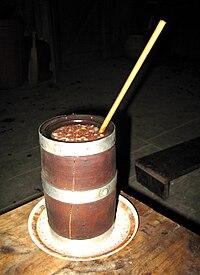
Photo from wikipedia
Objectives Modern breeding strategies have advanced our knowledge of factors influencing phenolic content in plant foods such as highbush (HB) blueberries. However, potential traits related to phenolic bioavailability remain unknown… Click to show full abstract
Objectives Modern breeding strategies have advanced our knowledge of factors influencing phenolic content in plant foods such as highbush (HB) blueberries. However, potential traits related to phenolic bioavailability remain unknown due to limitations in phenotyping methods. In vitro digestion models have proven useful for estimation of phytochemical bioavailability, however, these models remain inefficient for screening large germplasm collections. High throughput (HT) models suitable for screening of larger HB blueberry populations are needed to advance our knowledge of genotypes and genetic factors influencing phenolic density and bioavailability. Methods An established low throughput (LT) three stage in vitro digestion model previously used for fruit phenolics was adapted to reduce tissue amounts, digestion volume and modified enzyme concentrations allowing for compatibility with a robotic fluid handling system (TECAN EVO) for HT. Bioaccessibility of phenolics from commercial HB blueberries was optimized for HT and validated against the LT method. The HT model was then used to screen phenolic bioaccessibility in a subset of 33 individual blueberry genotypes derived from a mapping population of Draper x Jewel (DxJ) genotypes. Results Bioaccessibility of anthocyanins (ANC), flavonols (FLAV), flavan-3-ols (F3L) and phenolic acids (PA) were well correlated (R = 0.92) between HT and LT methods. Calculated CV ranged from 2-14% for HT and for LT 2-20% respectively suggesting good reproducibility. Phenolic content within the DxJ subset ranged from 31.7-81.1 mg/100 g fw. Approximately, 60% of the phenolics were ANC with chlorogenic acid (28%), FLAV (< 1%) and F3L (12%) accounting for the rest. Variation in bioaccessibility was observed within all phenolic classes with ANC (0.3-11.7; P < 0.001), Acylated ANC (7.9-31.8; P < 0.001), FLAV (14.4-52.7; P = 0.001), FL3(1.5-72.9; P = 0.002) and PA (0.2-7.9; P = < 0.001). Conclusions A HT in vitro digestion model provides a novel tool for phenotyping phenolic bioaccessibility in blueberry fruit. Application to a subset of DxJ genotypes further suggest that variation in phenolic bioaccessibility exist and highlights the need for investigation of diversity panels and mapping populations. Funding Sources Foundation for Food and Agriculture Research.
Journal Title: Current developments in nutrition
Year Published: 2019
Link to full text (if available)
Share on Social Media: Sign Up to like & get
recommendations!